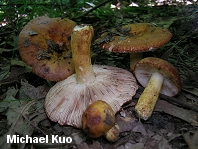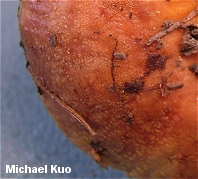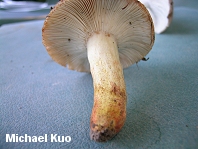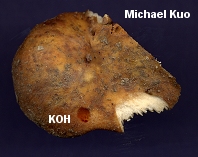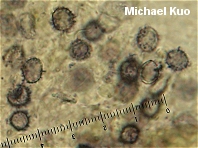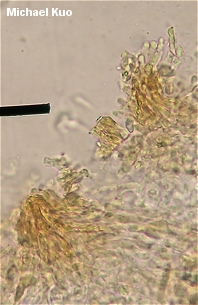| Major Groups > Gilled Mushrooms > Pale-Spored > Russula > Foetid Russulas > Russula mutabilis |

|
Russula mutabilis [ Basidiomycetes > Russulales > Russulaceae > Russula . . . ] by Michael Kuo One of the more distinctive members of the foetid russulas group, Russula mutabilis has a brownish orange cap that is initially covered with fine, yellowish powder--and an orangish yellow stem with a base that bruises deep red. It is associated with oaks in eastern North America. My collections of Russula mutabilis have all manifested a deep red color reaction when KOH is applied to the cap surface--a reaction not found in Russula fragrantissima, Russula laurocerasi, and other similar species. Description: Ecology: Mycorrhizal with hardwoods (probably exclusively with oaks); growing alone, scattered, or gregariously; summer and fall; apparently fairly widely distributed east of the Great Plains, from Illinois to Florida and New Jersey. Cap: 4-8 cm; convex, becoming broadly convex to flat with a shallow depression; sticky when wet and fresh; brownish orange to orangish brown; sometimes bruising slowly deep red; when young covered with fine yellow powder, especially near the margin; the margin lined; the skin peeling away easily at the margin, about halfway to the center. Gills: Attached or beginning to run down the stem; close or nearly distant; sometimes forked near the stem; creamy; often spotting or discoloring reddish brown to brownish. Stem: 2-6 cm long; 1-3 cm thick; whitish above, becoming bright yellow to orangish yellow below; bruising deep red, especially near the base; dry; more or less smooth. Flesh: Whitish. Odor and Taste: Odor weakly to moderately or strongly foul, reminiscent of maraschino cherries, almonds, or benzaldehyde; taste slowly but strongly strongly acrid. Chemical Reactions: KOH on cap surface deep red. Spore Print: Creamy. Microscopic Features: Spores 6-9 x 5-7 µ; broadly elliptical; with warts up to 1.5 µ high, connecting lines scattered and infrequent. Pileocystidia absent. Pulverulent covering composed of bundled, yellowish brown to orange-brown, cylindric to clavate elements. REFERENCES: Murrill, 1940. (Murrill, 1940; Hesler, 1960; Kibby & Fatto, 1990; Phillips, 1991/2005.) Herb. Kuo 07250303, 07300302, 07160704. My collections agree with Russula mutabilis in the sense of Kibby & Fatto (1990). However, Murrill's original description of the species does not mention yellow pulverulence, and calls for much more dramatic red staining and bruising, an only "slightly astringent" taste, and a white stem with a reddish brown base (before bruising); his description seems to match the mushroom depicted in Phillips 1991/2005) more than the one featured here. Hesler (1960), studying Murrill's type collection, found that "pulverulent areas composed of brownish, slender, erect hyphae" were "scattered over the surface," so it is possible that Murrill simply did not notice the powdery covering. Still, the differences seem fairly substantial, and it would not surprise me to find out that there are two distinct entities involved. This site contains no information about the edibility or toxicity of mushrooms. |
© MushroomExpert.Com |
|
Cite this page as: Kuo, M. (2009, March). Russula mutabilis. Retrieved from the MushroomExpert.Com Web site: http://www.mushroomexpert.com/russula_mutabilis.html |
